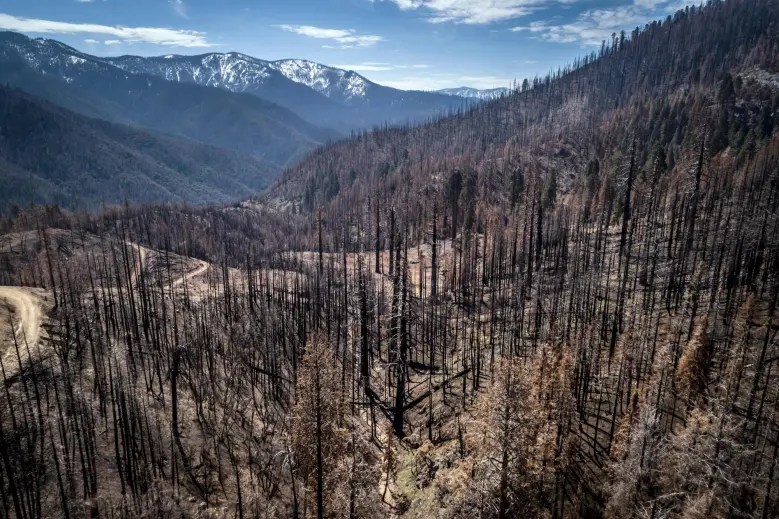This is a Denver Post op-ed from three of the (over 50) authors of the paper Steve posted (Davis et al., 2023) and we discussed, earlier here.

A burned hillside where crews are planting seedlings including Giant Sequoia in Mountain Home State Demonstration Forest outside Springville, Calif., on April 26, 2022. Destructive fires in recent years that burned too hot for forests to quickly regrow have far outpaced the government’s capacity to replant trees.
In the above photo, taken from the op-ed, I found a new idea.. that we need to keep living trees around as much as possible because we can’t scale up artificial regeneration otherwise (depending on assumptions about future fires). I had never heard that, but increasing the possibility of natural regeneration seems like a good idea for a number of reasons, biological and economic. Plus there is much truth to the difficulty of scaling up.
The op-ed goes into some of the mechanics that many of us have known to be true and seem obvious (dead trees (except for serotinous cones) produce no offspring). And shade helps surface temperatures.
Even when summers are hotter and drier after a wildfire than in the past, just having trees around that survived a fire helps new seedlings establish and grow.
Besides providing seeds, surviving trees reduce temperatures on the ground, where it matters most to seedlings. In some cases, temperatures can be 4 to 5 degrees Fahrenheit cooler (2.2 to 2.8 C) around surviving trees, giving seedlings the edge needed to germinate and survive.
In our study, projections of future forests varied dramatically, depending on how many trees we assumed survived future wildfires.
Of course, in many areas before and after burning we can see that topography and soils (or lack thereof, as Larry pointed out) affects which species grow successfully. And most (all) climate modeling doesn’t take that into account. Nevertheless, they go on to say..
Science supports the use of a number of tools, or forest treatments, that can help decrease the number of trees killed by wildfires.
Controlled burning with forest thinning or cultural burning by local Indigenous groups removes small trees and brush. That leads to fewer trees killed in subsequent fires, especially in forests that historically burned frequently. In high-elevation forests that historically experienced less frequent but more severe wildfires, planting trees after wildfires can help jump-start forest recovery.
Although forest treatments are effective, wildfires burn much more area than can be feasibly treated. Given this, fire scientists suggest letting some wildfires burn when conditions are safe and more likely to leave surviving trees on the landscape.
Expanding the use of wildfires and controlled burning as management tools is challenging, but the evidence suggests it may be one of the most effective and economical ways to reduce the number of trees killed by future wildfires.
There are clear ways to lessen the impacts of global warming and wildfires on seedlings and future forests. But in some areas, even as we work to reverse global warming, the window of opportunity is short. In these areas, forest treatments that modify wildfire or jump-start recovery will be most effective in the next few decades, setting up seedlings to better withstand near-term warming.
Perhaps fire ecologists views – thin when necessary, burn, sometimes plant where you need to; plus some WFU (or let me know what the current term is) are the way to go. Does anyone disagree with this?
“Stupid is stupid does ” , paid a handsome salary to expouse such nonsense !
Quoting from the authors:
“Expanding the use of wildfires and controlled burning as management tools is challenging, but the evidence suggests it may be one of the most effective and economical ways to reduce the number of trees killed by future wildfires.”
What Einsteins just said ?
So if you burn the forest , the trees , then there will be less trees burning in the future ! And u get paid to say that. Amazing how ignorant has man become..lets review…if we are concerned about loosing the 100 million trees in the forest to future fires, if we burn that forest and reduce it to 50 million , we will in the future have less trees catching afire…” thats quite a strategy” and you get paid?